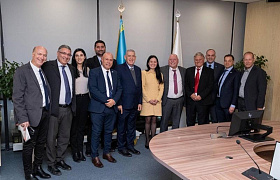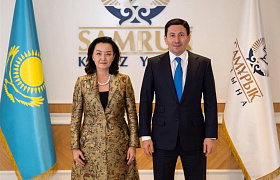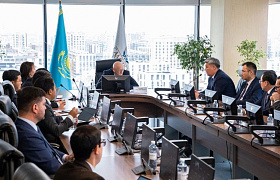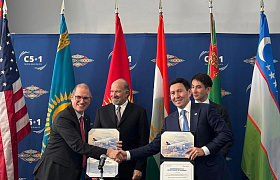Privatization as objective development requirement
1011
05 April 2016
The big-scale privatization of state companies is the step, to which Kazakhstan’s economy is prepared. Privatization is the straight way towards the growth of the country’s competitiveness. Privatization and transformation of state companies form that particular useful experience that lies in the foundation of the economic miracles worked in Singapore, South Korea, Malaysia and a number of other countries. Berik Beisengaliyev, member of Samruk-Kazyna Management Board and Assets Optimization Managing Director shares professional view on experience gained by other countries.
- Mr. Beisengaliyev, what is the strategic importance of privatization to Samruk-Kazyna companies? And how does it relate to the business transformation program actively conducted by the holding in the past two years?
- As per transformation program, our Fund is in pursuit of transition from an operations holding to a strategic entity. In other words, the Fund in future will not deal with the operations of its subsidiaries. Companies themselves will work on growth of their market value to become the best. Fund’s activities will be based on creation of new values. All over the world, strategic holding companies concentrate efforts on the following two scopes – more income generated by subsidiaries and investment into new perspective projects. The latter stands for quest of effective start-ups. Temasek of Singapore possesses valuable experience in the field. Privatization program works for the benefit of the transformation, because it allows our holding company to grow in profitability and become more market-oriented in the broadest sense. Privatization, in particular, means withdrawal of non-core business profiles from the structure of the Fund. Those are enterprises that distract our resources, both financial and human, from the core business. Besides, privatization contributes into the achievement of the transformation targets, namely optimization of the Samruk-Kazyna group structure. Privatization is of use to the national economy in general – new private enterprises enforce the foundation of the market economy and facilitate the further development of private businesses.
- The Fund, however, offers enterprises that are far from being Fund’s worst…
- Certainly. Samruk-Kazyna offers to private investment those companies that were created and commissioned as parts of governmental initiatives for diversification of economy and development of new industries. The majority of the enterprises that will be offered are firmly standing and rather successful and effective entities. It is important to remember that those enterprises were created and cultivated by state in the pre-planned manner. Why only state was capable of doing that? There is a number of objective reasons to that. That is, firstly, lack of experience and financial capabilities of the Kazakhstan private businesses – they just could not afford projects of such magnitude. Secondly, unpreparedness of our strategic partners, i.e. private investors, to make those projects work and provide the finances under acceptable conditions and without governmental guarantees. Private businesses were not, objectively, in the position to tow those projects. Today, the companies cultivated by the government need to be and must be transferred to free market environment.
Another category of the privatization objects is comprised of successfully operating enterprises and institutions that are not in the “blood relation” to the core business of the holding. For example, National Company Kazakhstan Temir Zholy is launching into the free market its Kazakh Academy of Transport and Communications named after M. Tynyshpayev. That Academy is one of the prestigious academic institutions with a long history, respectable staff of academic workers in the ranks of Professors and powerful academic tradition. The Academy, however, has no direct relations to the functions performed by the national railroad company. Kazakhstan Temir Zholy must deal with passenger and cargo transportation services, but education is not its core business. That is why that particular asset must be privatized.
- You said that privatization of some companies of the Fund will work for the benefit of diversification and growth of competitiveness of the national economy. Please substantiate your point of view.
- Let me clarify: it is particularly privatization of the strongest and most successful enterprises of the Fund, even partial, the one we are commencing now, shall create conditions for the fast growth of the most market effective sectors. Success examples from other parts of the world tell us that.
In the making of the privatization program we studied Singapore Government’s principles called Yellow Pages Rule. Yellow Pages Rule is that particular program, within the framework of which the world famous holding company Temasek underwent its transformation. According to Yellow Pages Rule, the government withdrew from sectors, where there was at least one private business competitor. In doing so, Temasek concentrated on the development of absolutely new industries. When Singapore achieved that, the national economy acquired a powerful growth stimulus.
That experience, by the way, proved very valuable: later it was used as the target example for other countries that were in pursuit of modernization and successfully achieved that. By 2014 to 2015 Kazakhstan achieved such economic development level, at which big-scale privatization and transformation become absolute pre-requisites for future modernization. This is when private investors too, and not only the government companies may become national economic growth drivers, as well as factors of its diversification and competitive status.
The privatization program performed by the Fund will help to promptly form such market environment that will ensure the best conditions for further modernization. In the final outcome, that, taken together will allow Kazakhstan to join the ranks of the most competitive economies of the world and do so in the faster way.
- And how did the first privatization round go for the Fund? Which particular objects were privatized in 2014-2015 and which of them enjoyed the highest demand?
- During the privatization campaign of 2014-2015 we sold 38 assets totaling KZT63.1 billion. Those assets included 22 assets owned by Kazakhstan Temir Zholy, 7 owned by KMG and 4 – by Kazakhstan Engineering. Samruk-Kazyna, Samryk-Energy, Kazatomprom and Samruk-Kazyna Real Estate Fund each delegated one subsidiary to the free market economy, as well. Besides, as you know, we fulfilled the JSC KEGOC Popular IPO for the amount in excess to KZT13 billion.
I must stress, that the Fund did not allow any cheapened sales in the course of privatization. In 2014, the sales prices turned out in excess to the starting prices by 6.9%, in average, while in 2015 году the exceedance was by 4%. If we look into general revenue generated in the course of privatization all over the country, then we will see that Samruk-Kazyna’s contribution is 78% of the total revenue. Expressed in figures, that is KZT63.1 of the total of 80.5 generated all over the Republic.
- Were there any hardships at the first stage of program implementation? There is information that following the first stage, the Fund improved privatization implementation mechanisms.
- There were no hardships. But the new Complex Privatization Plan for 2016-2020 really was made on basis of improved privatization approaches. In many instances, it was due to the requirement to ensure the maximum transparency in the course of assets privatization. We had to attract broad circles of investors and we were supposed to provide the maximum information to all concerned businessmen. The Plan envisages privatization of Samruk-Kazyna objects according to two approved lists.
Closer to the end of the past year, our Government adopted a Resolution approving the Complex Plan for Second Stage of Privatization Program. In process of execution of the second stage, we, as per approved plans, will transfer to the free market 783 assets currently owned by state and quasi-state sectors. 217 assets are presently parts of Samruk-Kazyna group of companies.
Samruk-Kazyna’s to be privatized assets were grouped as follows: 44 major and priority assets formed the first list and they will be privatized with the assistance from independent consultants. Thus, we will ensure the maximum transparency and control of the process. 7 of those 44 will be emit IPOs by 2020.
The second list of to be privatized assets, and those are 173 companies will be transferred to free market environment through simplified procedure, mainly by means of electronic auctions. Again, in the most transparent manner. We plan to complete privatization of those objects prior to the end of 2017.
- According to which particular principles, will major objects and enterprises, i.e. first list assets, be privatized? Will that not be to the detriment of the interests of state?
- We perform the broad-scale activity in regards to those assets. We hire independent consultants and they assist in the making of further roadmaps and implementation schedules. We are involved in a colossal intellectual exercise with one particular mission, which is to take account of all specific features of enterprises and offer privatization conditions that will be most optimal to the interests and purposes of the Fund. All that activity is performed under the control of the State Commission of Economy Modernization, which Commission is chaired by the Prime-Minister. That excludes any manipulations or lobbyism from potential concerned “players”.
I assure you, that interests of state shall in no manner be harmed in the course of privatization of the objects on that particular list. For example, we will allow to privatize not more than 25% of shares in the above mentioned 7 companies planned for IPO. Control packages of those companies, in any case, shall remain with the state and under the auspices of Samruk-Kazyna.
- Why did Samruk-Kazyna choose to suspend Popular IPO? Which company shares does Samruk-Kazyna plan to IPO in future?
- Popular IPO was suspended by decision of the Government. On my own behalf, I can stress that we, people working in the Fund, are interested in the performance of the IPO. According to the above mentioned Complex Privatization Plan, 7 of 44 major assets of the Fund are planned for IPO and those plans must be executed by 2020. Companies to undergo IPO are Kazakhsta Temir Zholy, Samruk-Energy, Tau-Ken Samruk, Kazpost, Air Astana and a number of others.
The global experience shows that when any company runs an open IPO, the campaign generates more revenue from the sales of shares. Besides, the company under IPO acquires unprecedented level of transparency and information disclosure, and its own assets under a realistic market evaluation, which evaluation is the most accurate of all possible and available ones, because it rests on the balance between the supply and the demand. Moreover a classical IPO mechanism is a globally recognized and adopted standard. That standard, by the way, does not prohibit private individuals to take their parts in the process.
So, I believe that in the near future citizens of Kazakhstan will be capable of becoming co-owners and shareholders in those companies and making good money from security market transactions.
Source: Kazakhstanskaya Pravda Newspaper
- Mr. Beisengaliyev, what is the strategic importance of privatization to Samruk-Kazyna companies? And how does it relate to the business transformation program actively conducted by the holding in the past two years?
- As per transformation program, our Fund is in pursuit of transition from an operations holding to a strategic entity. In other words, the Fund in future will not deal with the operations of its subsidiaries. Companies themselves will work on growth of their market value to become the best. Fund’s activities will be based on creation of new values. All over the world, strategic holding companies concentrate efforts on the following two scopes – more income generated by subsidiaries and investment into new perspective projects. The latter stands for quest of effective start-ups. Temasek of Singapore possesses valuable experience in the field. Privatization program works for the benefit of the transformation, because it allows our holding company to grow in profitability and become more market-oriented in the broadest sense. Privatization, in particular, means withdrawal of non-core business profiles from the structure of the Fund. Those are enterprises that distract our resources, both financial and human, from the core business. Besides, privatization contributes into the achievement of the transformation targets, namely optimization of the Samruk-Kazyna group structure. Privatization is of use to the national economy in general – new private enterprises enforce the foundation of the market economy and facilitate the further development of private businesses.
- The Fund, however, offers enterprises that are far from being Fund’s worst…
- Certainly. Samruk-Kazyna offers to private investment those companies that were created and commissioned as parts of governmental initiatives for diversification of economy and development of new industries. The majority of the enterprises that will be offered are firmly standing and rather successful and effective entities. It is important to remember that those enterprises were created and cultivated by state in the pre-planned manner. Why only state was capable of doing that? There is a number of objective reasons to that. That is, firstly, lack of experience and financial capabilities of the Kazakhstan private businesses – they just could not afford projects of such magnitude. Secondly, unpreparedness of our strategic partners, i.e. private investors, to make those projects work and provide the finances under acceptable conditions and without governmental guarantees. Private businesses were not, objectively, in the position to tow those projects. Today, the companies cultivated by the government need to be and must be transferred to free market environment.
Another category of the privatization objects is comprised of successfully operating enterprises and institutions that are not in the “blood relation” to the core business of the holding. For example, National Company Kazakhstan Temir Zholy is launching into the free market its Kazakh Academy of Transport and Communications named after M. Tynyshpayev. That Academy is one of the prestigious academic institutions with a long history, respectable staff of academic workers in the ranks of Professors and powerful academic tradition. The Academy, however, has no direct relations to the functions performed by the national railroad company. Kazakhstan Temir Zholy must deal with passenger and cargo transportation services, but education is not its core business. That is why that particular asset must be privatized.
- You said that privatization of some companies of the Fund will work for the benefit of diversification and growth of competitiveness of the national economy. Please substantiate your point of view.
- Let me clarify: it is particularly privatization of the strongest and most successful enterprises of the Fund, even partial, the one we are commencing now, shall create conditions for the fast growth of the most market effective sectors. Success examples from other parts of the world tell us that.
In the making of the privatization program we studied Singapore Government’s principles called Yellow Pages Rule. Yellow Pages Rule is that particular program, within the framework of which the world famous holding company Temasek underwent its transformation. According to Yellow Pages Rule, the government withdrew from sectors, where there was at least one private business competitor. In doing so, Temasek concentrated on the development of absolutely new industries. When Singapore achieved that, the national economy acquired a powerful growth stimulus.
That experience, by the way, proved very valuable: later it was used as the target example for other countries that were in pursuit of modernization and successfully achieved that. By 2014 to 2015 Kazakhstan achieved such economic development level, at which big-scale privatization and transformation become absolute pre-requisites for future modernization. This is when private investors too, and not only the government companies may become national economic growth drivers, as well as factors of its diversification and competitive status.
The privatization program performed by the Fund will help to promptly form such market environment that will ensure the best conditions for further modernization. In the final outcome, that, taken together will allow Kazakhstan to join the ranks of the most competitive economies of the world and do so in the faster way.
- And how did the first privatization round go for the Fund? Which particular objects were privatized in 2014-2015 and which of them enjoyed the highest demand?
- During the privatization campaign of 2014-2015 we sold 38 assets totaling KZT63.1 billion. Those assets included 22 assets owned by Kazakhstan Temir Zholy, 7 owned by KMG and 4 – by Kazakhstan Engineering. Samruk-Kazyna, Samryk-Energy, Kazatomprom and Samruk-Kazyna Real Estate Fund each delegated one subsidiary to the free market economy, as well. Besides, as you know, we fulfilled the JSC KEGOC Popular IPO for the amount in excess to KZT13 billion.
I must stress, that the Fund did not allow any cheapened sales in the course of privatization. In 2014, the sales prices turned out in excess to the starting prices by 6.9%, in average, while in 2015 году the exceedance was by 4%. If we look into general revenue generated in the course of privatization all over the country, then we will see that Samruk-Kazyna’s contribution is 78% of the total revenue. Expressed in figures, that is KZT63.1 of the total of 80.5 generated all over the Republic.
- Were there any hardships at the first stage of program implementation? There is information that following the first stage, the Fund improved privatization implementation mechanisms.
- There were no hardships. But the new Complex Privatization Plan for 2016-2020 really was made on basis of improved privatization approaches. In many instances, it was due to the requirement to ensure the maximum transparency in the course of assets privatization. We had to attract broad circles of investors and we were supposed to provide the maximum information to all concerned businessmen. The Plan envisages privatization of Samruk-Kazyna objects according to two approved lists.
Closer to the end of the past year, our Government adopted a Resolution approving the Complex Plan for Second Stage of Privatization Program. In process of execution of the second stage, we, as per approved plans, will transfer to the free market 783 assets currently owned by state and quasi-state sectors. 217 assets are presently parts of Samruk-Kazyna group of companies.
Samruk-Kazyna’s to be privatized assets were grouped as follows: 44 major and priority assets formed the first list and they will be privatized with the assistance from independent consultants. Thus, we will ensure the maximum transparency and control of the process. 7 of those 44 will be emit IPOs by 2020.
The second list of to be privatized assets, and those are 173 companies will be transferred to free market environment through simplified procedure, mainly by means of electronic auctions. Again, in the most transparent manner. We plan to complete privatization of those objects prior to the end of 2017.
- According to which particular principles, will major objects and enterprises, i.e. first list assets, be privatized? Will that not be to the detriment of the interests of state?
- We perform the broad-scale activity in regards to those assets. We hire independent consultants and they assist in the making of further roadmaps and implementation schedules. We are involved in a colossal intellectual exercise with one particular mission, which is to take account of all specific features of enterprises and offer privatization conditions that will be most optimal to the interests and purposes of the Fund. All that activity is performed under the control of the State Commission of Economy Modernization, which Commission is chaired by the Prime-Minister. That excludes any manipulations or lobbyism from potential concerned “players”.
I assure you, that interests of state shall in no manner be harmed in the course of privatization of the objects on that particular list. For example, we will allow to privatize not more than 25% of shares in the above mentioned 7 companies planned for IPO. Control packages of those companies, in any case, shall remain with the state and under the auspices of Samruk-Kazyna.
- Why did Samruk-Kazyna choose to suspend Popular IPO? Which company shares does Samruk-Kazyna plan to IPO in future?
- Popular IPO was suspended by decision of the Government. On my own behalf, I can stress that we, people working in the Fund, are interested in the performance of the IPO. According to the above mentioned Complex Privatization Plan, 7 of 44 major assets of the Fund are planned for IPO and those plans must be executed by 2020. Companies to undergo IPO are Kazakhsta Temir Zholy, Samruk-Energy, Tau-Ken Samruk, Kazpost, Air Astana and a number of others.
The global experience shows that when any company runs an open IPO, the campaign generates more revenue from the sales of shares. Besides, the company under IPO acquires unprecedented level of transparency and information disclosure, and its own assets under a realistic market evaluation, which evaluation is the most accurate of all possible and available ones, because it rests on the balance between the supply and the demand. Moreover a classical IPO mechanism is a globally recognized and adopted standard. That standard, by the way, does not prohibit private individuals to take their parts in the process.
So, I believe that in the near future citizens of Kazakhstan will be capable of becoming co-owners and shareholders in those companies and making good money from security market transactions.
Source: Kazakhstanskaya Pravda Newspaper
Рекомендуем

{{ $t('messages.news1') }}
The Management of Samruk-Kazyna JSC Met with a Delegation from the Sta...

{{ $t('messages.news1') }}
Nurlan Zhakupov, Chairman of the Management Board of Samruk-Kazyna JSC...

{{ $t('messages.news1') }}
Gas Industry Development: QazaqGaz to Report on Results and Projects

{{ $t('messages.news1') }}
A Number of Documents Signed by the Samruk-Kazyna Group during the Vis...


